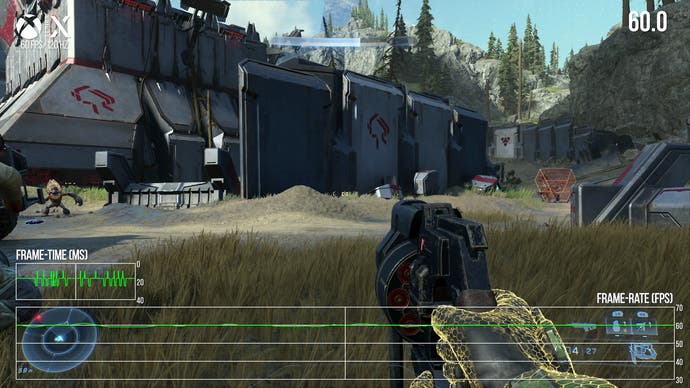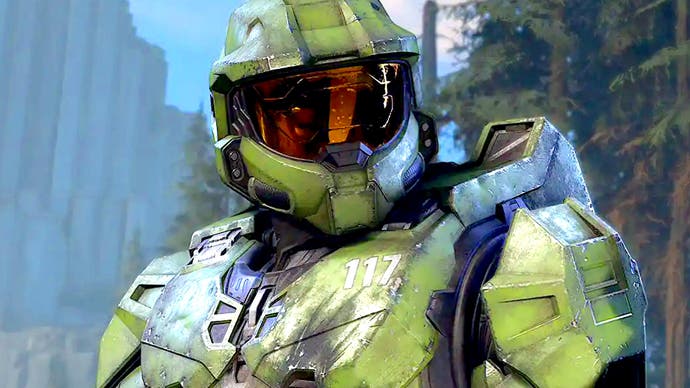Halo Infinite's Season 2 patch fixes long-standing animation bugs, adds new graphics modes
Strong progress - but serious frame-pacing and VRR issues remain.
Halo Infinite was rough around the edges on release with animation issues, frame-pacing woes and extra problems in cutscenes. Some issues were tackled post-launch, but it's with the release of the Season 2 patch that some long-standing issues have finally been resolved. We took a look at the fixes that 343 Industries has put in place on PC and Xbox Series X/S, covering animation, cutscenes and graphical modes, and identified some lingering issues with frame-pacing, v-sync and VRR that unfortunately still persist.
Let's start with the good stuff first: Halo Infinite makes a much better first impression on PC, Series X and Series S, thanks to fixes to long-standing issues with the game's pre-rendered cutscenes. After the patch, colours and black levels are now correct and the pre-rendered video sequence plays back with proper frame-pacing, making it feel much smoother and more polished as a result. This might not sound like a big deal, but this sequence cost a lot of money to make, it's key to the game's initial story-telling and for it to present the way it did at launch is a mystery. Still, the problem's now solved - and the improvement is palpable: it looks right, the washed out look is gone and the jerky playback issues are finally fixed.
Cutscene playback - an issue we highlighted pre-launch and that Microsoft told us would be patched - has finally been fixed too. This one is weird: even if the game ran consistently at 60fps or 120fps, actual movement within the cutscene was very jerky and very offputting, giving the illusion of a much lower performance level. This fix comes as a real relief, greatly improving the visual quality of all cutscenes, working nicely in comination ith smaller fixes like the prevention of lights flickering when you fly out to do the first open world mission. That said, one issue still remains: facial animations of all types still play out at 30fps, something that didn't occur in pre-release footage circa 2020. Hopefully this too can be fixed in an upcoming release, so that cutscenes can look as good as they should.
New graphical modes have also been added to Xbox Series consoles, while other modes have been renamed based on their frame-rate targets. That means that the Series X and Series S now each have three modes to choose from: 30fps, 60fps and 120fps. The Series S 120fps mode actually debuted with the beta flight of the game, but disappeared for launch. This HFR mode achieves its target by dropping resolution considerably, although other settings like draw distance and effects usage stay the same. With this mode enabled, the game remains at a ~540p internal resolution with variable rate shading (VRS), with the final image temporally upscaled to 1080p. Unfortunately, VRS isn't a good fit for this low resolution, as it can sometimes cause intense flickering and large macro blocks that are quite distracting.
The image quality for frame-rate tradeoff works well indoors, especially in multiplayer where action is more or less a locked 120fps, but the open world sections of the game's campaign run at a juddery 70-90fps. Drops to lower frame-rates in action-packed moments or during rapid traversal can also occur, but it's clear that the mode delivers significantly higher frame-rates than the 60fps mode, which is the name of the game.
Series X also sees a 30fps mode, which caps the game's frame-rate to 30fps to ensure the highest possible internal resolution at a given moment. This mode still uses VRS, but it's less obvious due to the higher base resolution. In practice though, this mode doesn't offer a massive visual difference compared to the 60fps mode, and halving the frame-rate robs the game of a certain level of fluidity and responsiveness.

The 30fps mode also marks the return of our old nemesis: improper frame-pacing. Frames aren't delivered at a regular interval, so you get persistent frame-time spikes throughout play that break the stability the mode tries to achieve, ultimately rendering it redudant.
Unfortunately, the 30fps mode on Series X isn't the only place that experiences frame-pacing issues. In short, any mode that caps the frame-rate below the refresh rate of your TV or monitor exhibits the same problem, like playing the 60fps mode on a 4K 120Hz display which actually looks worse than playing the game at 60Hz - something that should never occur.
This issue affects all Xbox consoles and PC, while PC still has the v-sync bug that causes small, regular frame-time spikes - something we've been reporting on since the flighting process last summer. You might expect that using a variable refresh rate (VRR) would solve the issue, but unfortunately this does not currently behave as it should. For some reason, even simple camera movement can produce significant judder - again, this is very odd. By it very nature, VRR should smooth out stutter, but for whatever reason, it's not working.
So, following the Season 2 patch, Halo Infinite is in a better place than it was, with some long-standing issues finally resolved, even though several frustrating technical issues persist. All of these bugbears feel like fixable problems, so I hope we continue to see patches addressing them moving forward. After all, there's a great game here hiding behind these technical concerns, and more people should be able to experience it now following the Season 2 patch.








.jpg?width=291&height=164&fit=crop&quality=80&format=jpg&auto=webp)
